by Lisa Cooke | Mar 26, 2016 | 01 What's New, Church, Listeners & Readers
A Dutch genealogy researcher writes in with tips and encouragement for finding your family history in The Netherlands.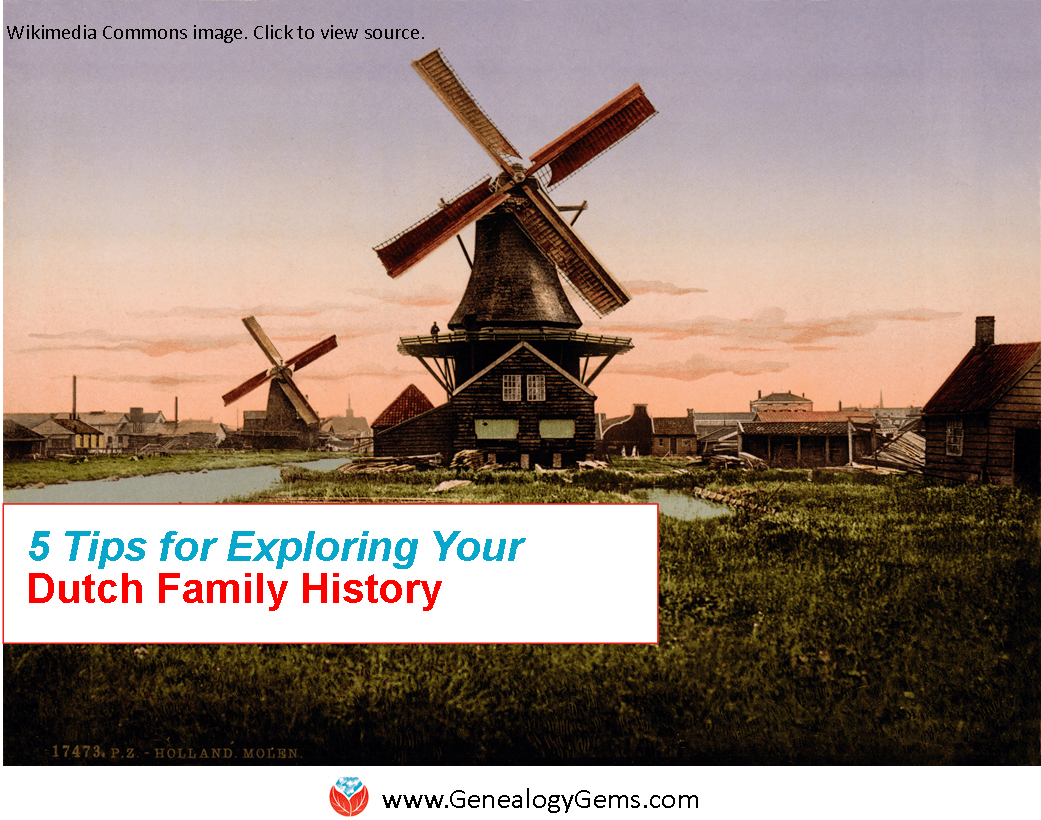
Niek in Arnhem, The Netherlands recently wrote in with 5 excellent and enthusiastic tips for exploring your Dutch family history. Here’s what he had to say about the civil registry, surnames, church records, land records and royal lineages:
“About three years ago my father got diagnosed with skin cancer and to help him get his mind of things I opened up an account on MyHeritage for us, so we could start working on our family tree together. Maybe I have some tips that could be of some value for your listeners with roots in The Netherlands:
1. Civil registry. In 1811, the civil registry was introduced by the French, who ruled the country. This meant that municipalities were obliged to keep the records (marriage, death and birth) of their citizens. That system hasn’t changed much since 1811 and most of the information can be found online on websites like www.wiewaswie.nl and www.geneaknowhow.net (the latter has some English translations as well). It’s very easy to find your Dutch ancestors [back] to 1811. For example, I know the names and most of the date of births and deaths of 60 of my 64 four-times great-grandfather who lived during the introduction of the civil registry.
For me, the most exciting thing about these post-1811 documents is that they were often signed by the father of the newborn or by the bride and groom. To see the 200 year-old signature of your ancestor can really send shivers down the spine! [Click here to read more about Dutch civil registration on the FamilySearch wiki.]
2. Surnames. The introduction of the civil registry also meant that citizens had to have a last name. Up to then last names were used, but not mandatory. It could be that last names would change after a generation. For example, my last name, Lucassen means Son of Lucas, my oldest paternal ancestor I could find was named Lucas Jans, which means Lucas, son of Jan. And his son was called Jan Lucassen, and this last name was passed down the generations (although some of his children had Janssen, son of Jan, as a last name).
3. Catholic church records. I am from the province of Brabant, which was a Catholic province. Before 1811, records were kept by the church. The Catholic church was particularly skilled at keeping records and information. Although they unfortunately don’t have dates of birth and dates of death, they used to register the dates of baptism and burial. (A baptism date isn’t the same as a a date of birth, although, in the civil registry marriage certificates, the date of birth is the same as the date of baptism.) [Click here for a FamilySearch wiki article on Dutch church records.]
4. Land records. Apart from the church the municipalities kept records of sales of land and property, which is a great way to find out more about the family relations of your ancestors, and about the houses they may have owned. For many parts of the country, these records can easily go back to the 17th century. [This FamilySearch wiki article tells you more about Dutch land and property records.]
5. Royal lineages. If you’re lucky you’re able to connect one of the branches of your family tree to nobility, as many parts of The Netherlands and the rest of Europe were ruled by knights and viscounts. If this is the case in your family, you can easily climb up in your family tree for several centuries because the family relationships of nobility is very well documented and an important part of their heritage (like the story you told about your visit to Windsor Castle) because of the possession of land over which they ruled. Sometimes you do hit a dead-end when a parent of one of your ancestors isn’t known, or isn’t known for certain. But some of the lines travel back really, really far! [Click here for a FamilySearch Wiki article with more on researching noble lines.]
More Dutch Genealogy Gems
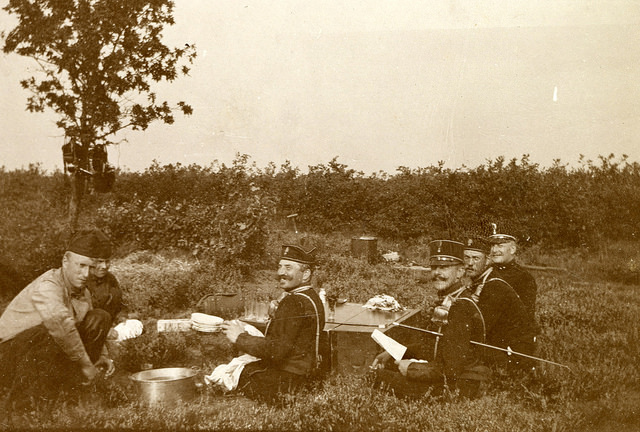
“Exercise Field Artillery Corps” album, image AKL092038, Netherlands Institute of Military History uploads at Flickr Creative Commons, https://www.flickr.com/photos/nimhimages/16026248719/.
Dutch Reformed Church Records (U.S.) on Ancestry.com
Europeana Digital Archive: World War I Collection
Netherlands Military Institute of History has Flickr Photostream
by Lisa Cooke | Oct 11, 2017 | 01 What's New, FamilySearch, Genealogy Gems Podcast, Military
Genealogy Gems Podcast Episode 209
with Lisa Louise Cooke
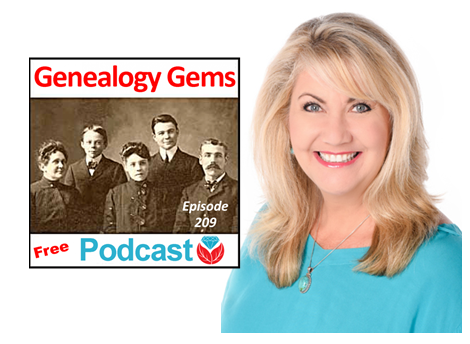
In today’s episode:
- David Ouimette of FamilySearch is known to his colleagues as “the Indiana Jones of genealogy” because of his globe-trotting adventures in curating record treasures. He joins us to talk about the millions of records being digitized around the world right now.
- Lots of excited emails from you!
- Compiled military service records from Military Minutes expert Michael Strauss
GENEALOGY GEMS EVENTS
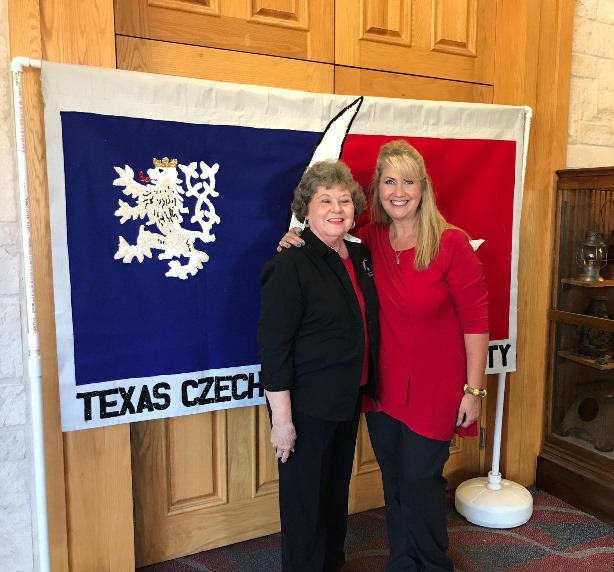
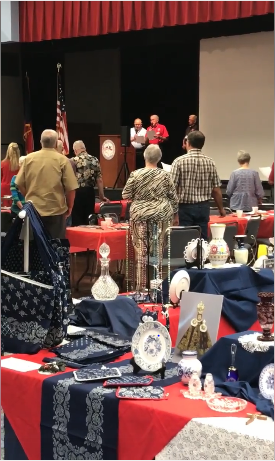
Thanks for a great seminar, Texas Czech Genealogical Society! (shown right: the beautiful items you see in the foreground are Czech crystal and other traditional items)
Jake’s Texas Tea House, Waco, TX
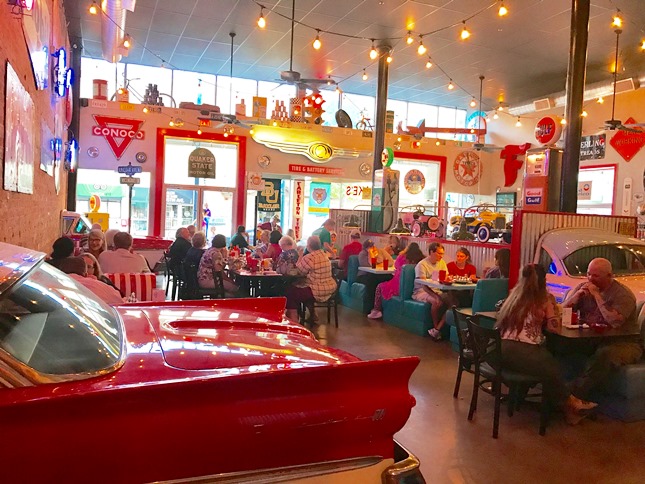
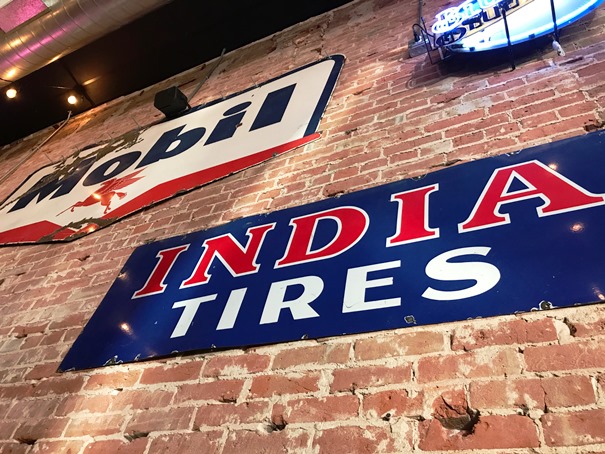
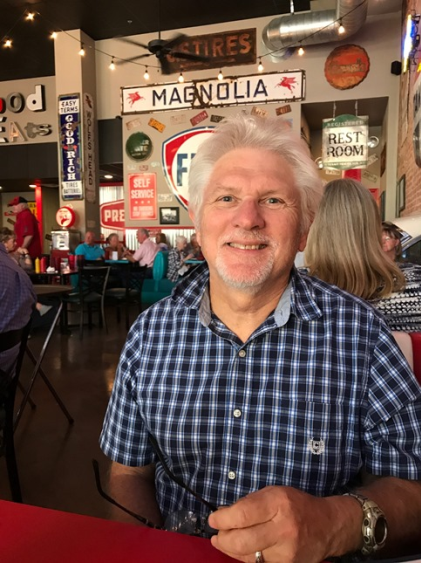
Bill at Jakes
Magnolia Market at the Silos
NEWS: ROOTSMAGIC UPDATE

Free update for RootsMagic 7 users: version 7.5.4.0 (update primarily fixes bugs). Click on the “Update Available” indicator in the lower right corner of your RootsMagic 7 program screen.
If you don’t already have RootsMagic 7, click here to see what’s new Or click here to order the upgrade.
RootsMagic’s new TreeShare for Ancestry
Genealogy Gems Mailbox


Gray recommends Lisa’s free Family History: Genealogy Made Easy Podcast
MAILBOX: FREE WEBINAR RESPONSES
“Reveal Your Unique Story through DNA & Family History”
RootsTech 2018: A First Look
RootsTech Q&A
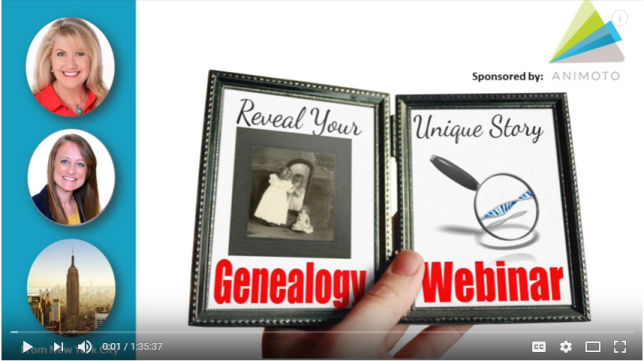
Click the image above to watch the video
Click the red SUBSCRIBE button on the Genealogy Gems YouTube channel.
NEW GENEALOGY GEMS PREMIUM VIDEO

Develop your search superpowers to uncover information about your family history on the web with Google at lightning speed! Explore tools like Image search, facial recognition, finding specific types of files, how to find the answers you need, and more. Click here to watch a class preview; click here to become a Genealogy Gems Premium member.
BONUS CONTENT for Genealogy Gems App Users
If you’re listening through the Genealogy Gems app, your bonus content for this episode is an easy-to-access version of the new Genealogy Gems Premium video, “Google Search Secrets.” The Genealogy Gems app is FREE in Google Play and is only $2.99 for Windows, iPhone and iPad users.
INTERVIEW: DAVID OUIMETTE OF FAMILYSEARCH
David Ouimette, CG, manages Content Strategy at FamilySearch. He has conducted research and analyzed archival materials in dozens of countries in North and South America, Europe, Africa, and Asia. David lectures regularly and has written for genealogists, including Finding Your Irish Ancestors: A Beginner’s Guide.

Genealogy Gems Contributing Editor Sunny Morton is the author of “Genealogy Giants: Comparing the 4 Major Websites.” (discontinued) Use this jammed-packed cheat sheet to quickly and easily compare the most important features of the four biggest international genealogy records membership websites: Ancestry.com, FamilySearch.org, Findmypast.com and MyHeritage.com. Consult it every time your research budget, needs or goals change!
Start creating fabulous, irresistible videos about your family history with Animoto.com. You don’t need special video-editing skills: just drag and drop your photos and videos, pick a layout and music, add a little text and voila! You’ve got an awesome video! Try this out for yourself at Animoto.com. Use coupon code YEAR15 for 15% off annual plans through 12/31/17.

MyHeritage.com is the place to make connections with relatives overseas, particularly with those who may still live in your ancestral homeland. Click here to see what MyHeritage can do for you: it’s free to get started.
MILITARY MINUTES: COMPILED MILITARY SERVICE RECORDS

If a clue found in your ancestor’s US draft registration records listed military service you will want next to search for his Compiled Military Service Record (CMSR).
The Compiled Military Service Records (often abbreviated at CMSR or CSR) record the name, unit, and period of service of the veteran along with information related to military service from the Revolutionary War to the end of the hostilities of the Philippine Insurrection after the turn of the 20th century.
The information varies greatly from each of the war periods that recorded this information. Besides the identifying features listed above, they typically contain muster in/out information, rank in/out details and further highlight the soldier career by recording promotions, prisoner of war memorandums, casualties, and a number of personnel papers which may include enlistment papers and other related documents. Several of the war periods also provide physical descriptions of the soldiers including; name, age, nativity, occupation, height, hair, eyes, and complexion information. This set of records represents the volunteer Army and doesn’t include regular Army enlistments. Except for limited records of the Revolutionary War and the War of 1812 for the Navy, the other branches of the military (including Navy, Marines, and Revenue Cutter Service) all have their equivalent set of records.
Your ancestor may have multiple entries in the CMSR. This could occur if a soldier served in more than one unit, or in the case of John LeMaster, who enlisted in two different armies. The Civil War divided our nation, testing the loyalty of all persons who lived during this time. Lemaster chose the Confederacy (as least initially) when in 1861 in Charlestown, VA he enlisted with the 2nd VA Infantry fighting alongside of his Brigade commander Thomas J. Jackson who later would be known as “Stonewall Jackson.” (Photos: John H. Lemaster and his family in Martinsburg, WV. Photos courtesy of Michael Strauss.)
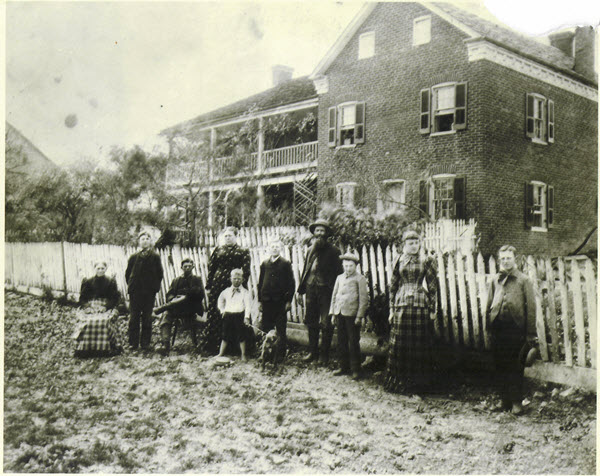
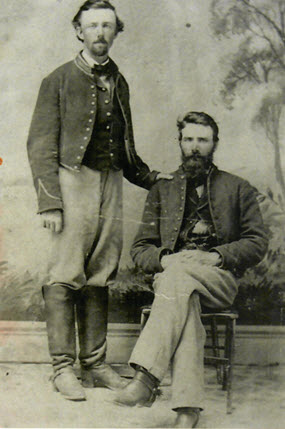
After the Confederate loss at the battle of Gettysburg he deserted and lived in Martinsburg in what was now West Virginia where on his Draft Registration he was listed as a deserter from the Rebel Army. In 1864 he enlisted in the United States Army with the 3rd WV Cavalry, serving out the duration of the war until 1865. After the war he was granted a federal pension, with no mention of his former service in the Confederacy.
Shown on following pages: his military service records for both the Confederate and Union armies.
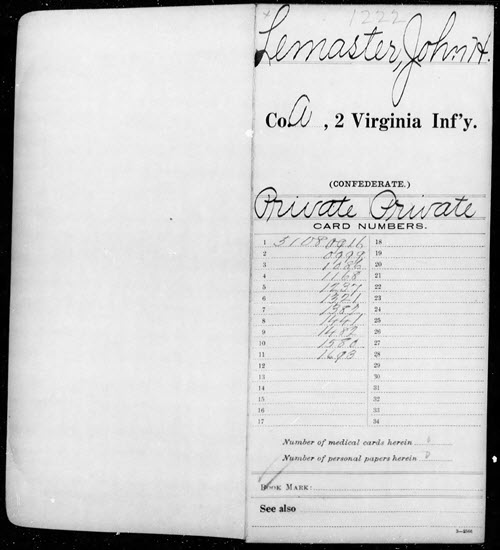
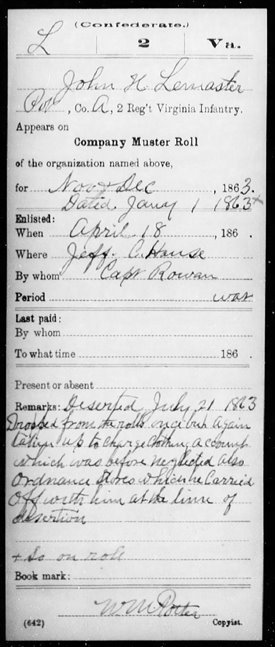
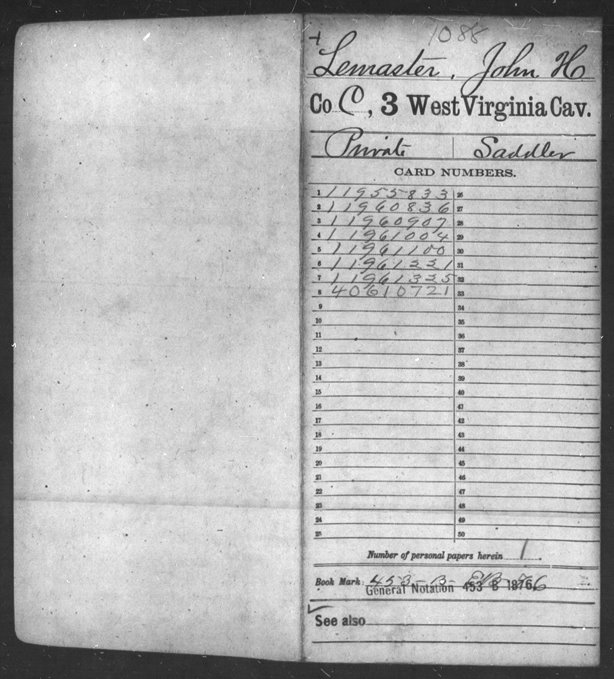
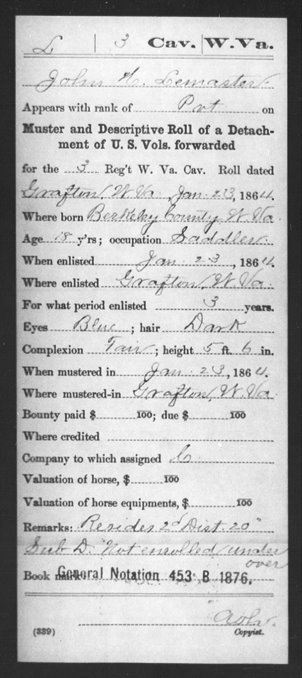
Access various CMSR indexes and images online at the following:
At fold3:
Revolutionary War. Compiled Military Service Record images are online for CT, DE, GA, MD, MA, NH, NJ, NY, NC, PA, RI, SC, VT, VA, and Continental Troops. Genealogists should also search the local state where their ancestors were from as some Militia isn’t included in these records.
During the Revolutionary War additional Compiled Service Records were completed for the Navy, which was broken down to include Naval Personnel, Quartermaster General, and Commissary General Departments.
One additional set of CMSR images covered Revolutionary War service along with Imprisonment Cards. Click here
Old Wars (1784-1811). After the Revolutionary War, the newly formed United States government sought to maintain a regular Army. However, volunteer soldiers who served from 1784-1811 were recorded. (One of the reasons for volunteers to be called up would have included the Whiskey Rebellion of 1793.) Their Compiled Military Service Record full images are available online here.
War of 1812. Compiled Military Service Records Indexes are online for CT, DE, DC, GA, IL, IN, KY, LA, MD, MA, MI, MS, MO, NH, NJ, NY, NC, OH, PA, RI, SC, TN, VT, VA and also the Cherokee, Chickasaw, Choctaw, Creek, and Shawanoe Indians along with United States Volunteers. Full copies of CMSR are online for the Chickasaw and Creek Indians, along with the men from Lake Erie and Mississippi.
Indian Wars. Compiled Military Service Records Indexes are online for the various Indians wars from 1815-1858.
Mexican War. Compiled Military Service Record indexes are online for AL, AR, CA, FL, GA, IL, IN, IA, KY, LA, MD, DC, MA, MI, MS, MO, NJ, NY, NC, OH, PA, SC, TN, TX, VA, WI, and the Mormon Battalion and the United States Volunteers. Full copies of the CMSR are online for AR, MS, PA, TN, TX, and the Mormon Battalion.
Civil War. Click here to search:
- Union: Indexes are online for AZ, CA, CO, CT, IL, IN, IA, KS, ME, MA, MI, MN, MO, NH, NJ, NY, OH, PA, RI, VT, WA, WI, United States Veteran Volunteers, and Veteran Reserve Corps. Full copies of CMSR for AL, AR, CA, CO, Dakota Territory, DE, DC, FL, GA, KY, LA, MD, MA, MS, MO, NE, NV, NM, NC, OR, TN, TX, UT, VT, VA, WV, United States Colored Troops, United States Volunteers, and 1st NY Engineers.
- Confederate: indexes are online for AL, and VA. Full copies of CMSR are online for AL, AZ, AK, FL, GA, KY, LA, MD, MO, MS, NC, SC, TN, TX, VA, Miscellaneous, Volunteers, Indians, and Officers.
Spanish American War. Compiled Military Service Record Indexes are online for AL, AR, CA, CO, CT, Dakota Territory, DE, DC, FL, GA, ID, IL, IN, IA, KS, KY, LA, ME, MD, MA, MI, MN, MS, MO, MT, NE, NV, NH, NJ, NY, NC, ND, OH, OK, OR, PA, PR, RI, SC, SD, TN, TX, UT, VT, VA, WA, WV, WI, WY, and United States Volunteers.
Full copies of CMSR are online for FL.
At Ancestry.com:
Revolutionary War. Full copies of the Compiled Military Service Records for CT, DE, GA, MD, MA, NH, NJ, NY, NC, PA, RI, SC, VT, VA, and Continental Troops. This database often doesn’t list the local militia as most of the men listed were part of the continental line. Researchers can access this group of records and search by keyword or location. Search here
Old Wars. This database is an index and full images of the Compiled Military Service Records of those men who served after the Revolutionary War and before the War of 1812, covering the years of 1784-1811.
War of 1812. Abstracted lists of names, state, and military units from the Compiled Service Records (no images). Search here
Indian Wars: Database with images for Florida: includes the Florida Wars, Second Creek War, and the Third Seminole War from 1835-1858
Mexican War. Full copies of the CMSR are online for MS, PA, TN, TX, and the Mormon Battalion. Search here
Civil War:
- Union:Compiled Military Service Records are searchable, with a link to the collection on Fold3 here
- Confederate: Compiled Military Service Records are searchable, with a link to Fold3 to view original images here. An additional set of Service Records comes from units that were raised by the Confederate Government and not from any of the states that comprised the Confederacy. The CMSR are available online to view the images and searchable by military unit here.
Spanish American War. Compiled Military Service Record Indexes are online that cover the same geographical areas as on Fold3 here. Full copies of CMSR are online on Ancestry for Florida here.
Free at FamilySearch.org:
Family Search has fewer Compiled Military Service Records available online that include images. One of the major collections includes the Revolutionary War CMSR’s that when searched here, the images provide a direct link to Fold3.
Most of the other major war periods are microfilmed and available through the Family History Library in Salt Lake City, Utah. With online access through both Fold3 and Ancestry provided on the computers in the library, accessing the film is less desirable.
GEM: USNEWSMAP
UsNewsMap.com
Free video helps you visualize where historic newspapers are located in the US
Suzanne’s comment: “Did you realize that this site from the Georgia Tech Research Institute is actually a wonderful search engine for Chronicling America.loc.gov. website? I have used the LOC site often, but found it cumbersome sometimes. This is a real time saver. Thanks for the Genealogy Gem.”
Lisa’s tip: In the timeline you can specify a date, like 1860 (date and month too!), then press play and it will play back and reveal the locations on mentions of your search query coming forward in time. It would be really interesting to take a word or phrase and see when it first occurred. This is a very feature-rich website!
A short YouTube video documentary on Leavittown: it’s a great example of the do-it-yourself video narratives you can make to tell your own family’s stories!
KEEP UP WITH GENEALOGY GEMS
Listen to the Genealogy Gems Podcast twice a month! Check in on or after October 26, 2017 for Genealogy Gems Podcast Episode 210. What’s coming? Paul Woodbury of Legacy Tree Genealogists will share some great tips for beginning Swedish genealogy?and much more!
Follow Genealogy Gems on Instagram
Subscribe to the Genealogy Gems YouTube channel


Disclosure: This article contains affiliate links and Genealogy Gems will be compensated if you make a purchase after clicking on these links (at no additional cost to you). Thank you for supporting Genealogy Gems!
PRODUCTION CREDITS
Lisa Louise Cooke, Host and Producer
Sunny Morton, Editor
Diahan Southard, Your DNA Guide, Content Contributor
Vienna Thomas, Associate Producer
Hannah Fullerton, Production Assistant
Lacey Cooke, Service Manager
Resources
Download the episode
Download the show notes PDF
by Lisa Cooke | Feb 17, 2020 | 01 What's New, Records & databases
There are a wide range of genealogical records newly available online. Here are new and updated collections as of this week. We’ve included important information about each collection that will help you determine whether it is suitable for your genealogical research. We include affiliate links for which we may be compensated, at no expense to you. Thank you for supporting free article like this by using our links.
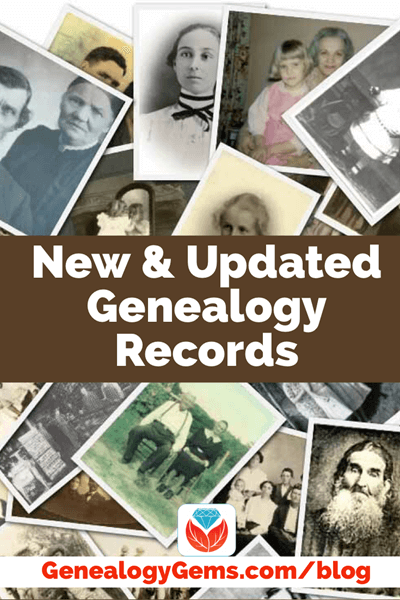
The latest genealogy records from Genealogy Gems.
NEW: HALL COUNTY NEBRASKA NEWSPAPER DIGITIZATION PROJECT
About the collection:
“The Hall County Newspaper Digitization Project is a collaborative project supported by the historical and genealogical societies, newspapers, public libraries, and museums in Hall County. This project will digitize the 28 historic newspapers published in Hall County since 1870. The Grand Island Independent (up to 1924) is included in this project.”
Newspapers included in the first completed phase of digitization include:
- Platte Valley Independent (1870-1884);
- Grand Island Times (1873-1892);
- Grand Island Independent (1884-1900);
- Wood River Gazette (1884-1892);
- Doniphan Eagle (1892-1895);
- Staats-Anzeiger und Herald (1894-1918);
- Wood River Interests (1894-1919);
- Wood River Sunbeam (1906-2003).
Search the collection here.
DIGITAL LIBRARY OF GEORGIA
Sanborn Fire Insurance Maps (Select Georgia towns and cities. 1923-1941)
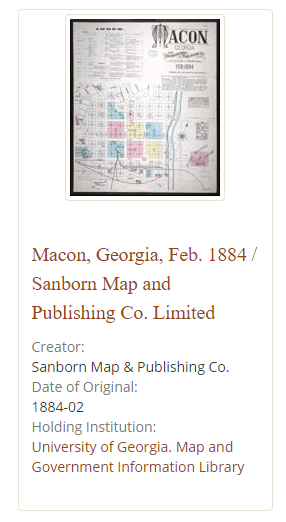
Sanborn Fire Insurance Maps at the Digital Library of Georgia
About the collection:
“The Digital Library of Georgia has just made Sanborn fire insurance maps produced between 1923-1941 for 39 Georgia towns and cities in 35 counties freely available online. The maps, which are now in the public domain, can be retrieved at dlg.usg.edu/collection/dlg_sanb, and complement the DLG’s existing collection of the University of Georgia Map and Government Information Library’s 539 Sanborn maps dating from 1884-1922 that have been available since 2005. The DLG has also upgraded its image viewer, which will allow better access and improved navigation to the new and older Sanborn images from this collection.”
Search the collection here.
MYHERITAGE
Search the following collections here at MyHeritage.
NEW: New York, Birth Index, 1881-1942
About the collection:
“This collection consists of indexes of births from the state of New York between the years 1881 and 1942. The State of New York began statewide registration of births in 1881, supervised by the local board of health. A record may include the following information when it is available: given name and surname, birth date, town of birth, and gender. The images in this collection have been obtained through the outstanding work and efforts of Reclaim the Records.
This index does not contain lists of births from New York City. New York City is considered to be a separate vital records jurisdiction from the rest of New York state, and consequently the city has its own birth indices. However, a small number of New York City birth listings are found throughout this index. This is due to the births happening in towns that were previously independent before the consolidation of the city in 1898 (for example, a pre-1898 birth in a place like Canarsie [Brooklyn] or Flushing [Queens] might be listed here) or because there was a late birth registration.”
NEW: Minnesota, Death Index, 1904-2001
About this collection:
“This collection includes an index of death records from Minnesota, between 1904-2001. Information may include the deceased name, date of death, county of death, date of birth, county of birth and certificate number. It may also include the mother’s maiden name when available.
Information for the years 1908-2001 is recorded from death certificates as recorded by a physician or a mortician. Information in this collection for years prior to 1908 is taken from death cards. Unlike death certificates, many death cards were filled out very incompletely. Cards, especially for the cities of Minneapolis and St. Paul, frequently contain little more information than the name of the decedent, date of death, sex, marital status, birthplace, cause of death, and person reporting the death.”
Number of records: 4,460,579
NEW: Minnesota, Birth Index, 1900-1934
About this collection:
“This collection contains an index to birth records from Minnesota between 1900-1934. Information may include: first name, middle name, and last name of the child. It may also include the date and county of birth, certificate number. It may also include the mother’s maiden name when available.
Birth certificates were used to record birth information beginning in 1907. When a child was born, a physician or midwife compiled information about the child on a birth certificate. The certificate was registered with the local county registrar. Birth cards were used to collect birth information from 1900 to 1907. Unlike birth certificates, many birth cards were not completely filled out. 80% of this collection takes place between 1907-1937, 19% is from 1900-1907 and 1% is from before 1900.”
Number of records: 3,406,802
Updated: MyHeritage Photos and Docs
About this collection:
“This collection includes public photos, videos and documents posted by MyHeritage members on their family sites. You may contact a member who submitted a photo to get in touch or request additional information.”
Number of records: 141,129,707
ANCESTRY
U.S. City Directories, 1822-1995
About the collection: “This database is a collection of directories for U.S. cities and counties in various years. The database currently contains directories for all states except Alaska.
Generally a city directory will contain an alphabetical list of citizens, listing the names of the heads of households, their addresses, and occupational information. Sometimes a wife’s name will be listed in parentheses or italics following the husband’s. Other helpful information might include death dates for individuals who had been listed in the previous year’s directory, names of partners in firms, and forwarding addresses or post offices for people who had moved to another town.”
Search the collection here.
NEW: New York State, Address Notification and Absentee Ballot Application Cards, 1944
About the collection:
“This collection consists of notices received in 1944 by the War Ballot Commission from members of the United States Armed Forces, American Red Cross, and other service organizations serving in World War II that resided in New York requesting absentee ballots or notifying the office of a change in address. For more information on this collection, please visit the Finding Aid page on the New York State Archives site. There are two main forms present in this collection – pre-printed applications for war ballot, and postcards with change of address information.”
Information contained varies, and may include:
- soldier’s name
- soldier’s rank or rating and service number
- soldier’s birth date
- soldier’s residence at time of request
Search the collection here.
Updated: 1860 U.S. Federal Census – Slave Schedules
About the collection:
“The slave schedule was used in the following states: Alabama, Arkansas, Delaware, Florida, Georgia, Kentucky, Louisiana, Maryland, Mississippi, Missouri, New Jersey, North Carolina, South Carolina, Tennessee, Texas, Virginia.”
Search the collection here.
Updated: 1850 U.S. Federal Census – Slave Schedules
About the collection:
“The slave schedule was used in the following states: Alabama, Arkansas, Delaware, Florida, Georgia, Kentucky, Louisiana, Maryland, Mississippi, Missouri, New Jersey, North Carolina, South Carolina, Tennessee, Texas, Virginia.”
Search the collection here.
Updated: New Zealand, Cemetery Records, 1800-2007
About the collection:
“These transcriptions of headstones from cemeteries in New Zealand typically include details such as name, birth date, death date, and the cemetery name and plot location. But they may also provide family relationships with name and other details about a spouse, cause of death, military dates, an epitaph, or even a description of the headstone.”
378,207 new records were added.
Search the collection here.
Updated: U.S. Virgin Islands, Danish West Indies Slave Records, 1672-1917
About the collection:
“This database contains Danish records relating to slavery in what became the U.S. Virgin Islands.
During Danish rule, officials kept voluminous records, including the slave-related records found in this database. They include the following:
- case papers concerning contested slave ownership
- emancipation records
- registers of free men, women, and children of color
- lists of baptisms, marriages, and burials
- lists of slave owners and former slaves
- mortgages and loans
- slave lists and censuses
- records of Royal Blacks
- compensation agreements
- courts martial
The records can be a valuable source of names, dates, places, and other details. These records have not yet been indexed, but they can be browsed by record type. Most of the records are in Danish.
This collection was previously published as image only. The collection has since been indexed and this update adds 80,184 new records.”
Search the collection here.
Updated: California, Voter Registrations, 1900-1968
About the collection: “This database consists primarily of the voter indexes published every two years, including indexes to the Great Registers, to affidavits for registration, and to precinct registers.
Voter registrations were kept on the county level by the county clerk. Indexes to these records are organized according to county and voting wards and/or precincts. Within each precinct voters are listed alphabetically according to surname.”
Information may include:
- Name
- Age
- Address
- Occupation
- Political Affiliation
Search the collection here.
UNIVERSITY OF NEVADA, RENO – CITY DIRECTORIES
The University Libraries has recently digitized early city directories of Reno, Sparks, and the surrounding areas, which date from 1900.
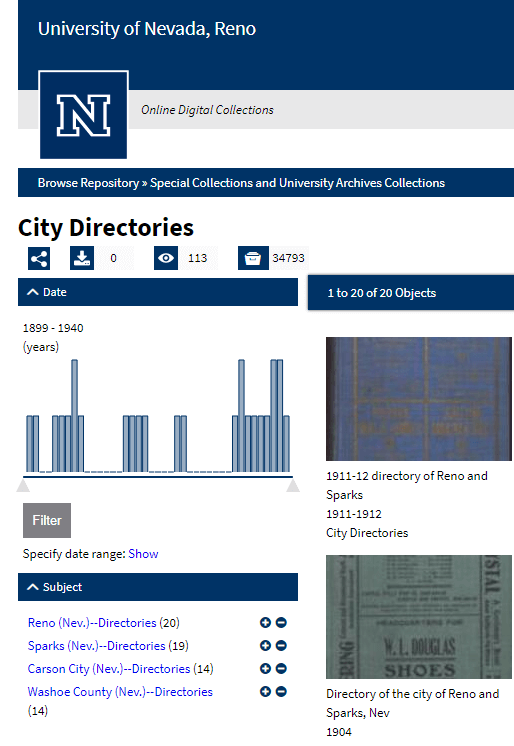
Nevada City Directories at the University of Nevada
Search the collection here.
FINDMYPAST
NEW: Canadian Directories & Almanacs
Findmypast has launched brand new collection with records from the province of Prince Edward Island. According to the company, more will be added from across Canada over the coming months.
About the collection:
“The eclectic mix of five directories cover the late 19th century from 1880 to 1899.”
The titles included are:
- Frederick’s Prince Edward Island Directory
- McMillian’s Agricultural and Nautical Almanac
- McMullan’s Almanac
- Teare’s Directory & Hand Book Of The Province of Prince Edward Island
- The Prince Edward Island Almanac
Search the collection here.
Updated: PERiodical Source Index (PERSI)
About the collection:
“Over 7,000 images have been added covering a variety of PERSI publications, perfect for fleshing out family stories. The new periodical titles that have been added are:
- Vermont Quarterly Gazetteer: A Historical Magazine / Bound With New Title: Vermont Historical Gazetteer
- Recherches Historiques
- Cambridge Historical Society Publications/proceedings
- Archivium Hibernicum / Irish Historical Records
- Queen City Heritage / Ohio Valley History
- Connecticut Historical Society Collections
Simply filter by periodical to get to the latest additions.”
Search the collection here.




























